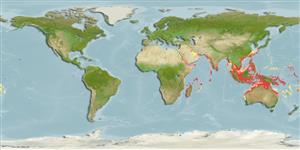Preferred temperature (Ref.
115969): 25 - 29.1, mean 28.2 (based on 1824 cells).
Phylogenetic diversity index (Ref.
82804): PD
50 = 0.5000 [Uniqueness, from 0.5 = low to 2.0 = high].
Bayesian length-weight: a=0.01514 (0.00985 - 0.02326), b=2.92 (2.80 - 3.04), in cm Total Length, based on LWR estimates for this species & Genus-body shape (Ref.
93245).
Niveau trophique (Ref.
69278): 4.2 ±0.6 se; based on diet studies.
Résilience (Ref.
120179): Milieu, temps minimum de doublement de population : 1,4 à 4,4 années (K=0.13-0.38).
Prior r = 0.40, 95% CL = 0.26 - 0.60, Based on 1 full stock assessment.
Fishing Vulnerability (Ref.
59153): High vulnerability (65 of 100).
Climate Vulnerability (Ref.
125649): Very high vulnerability (90 of 100).
